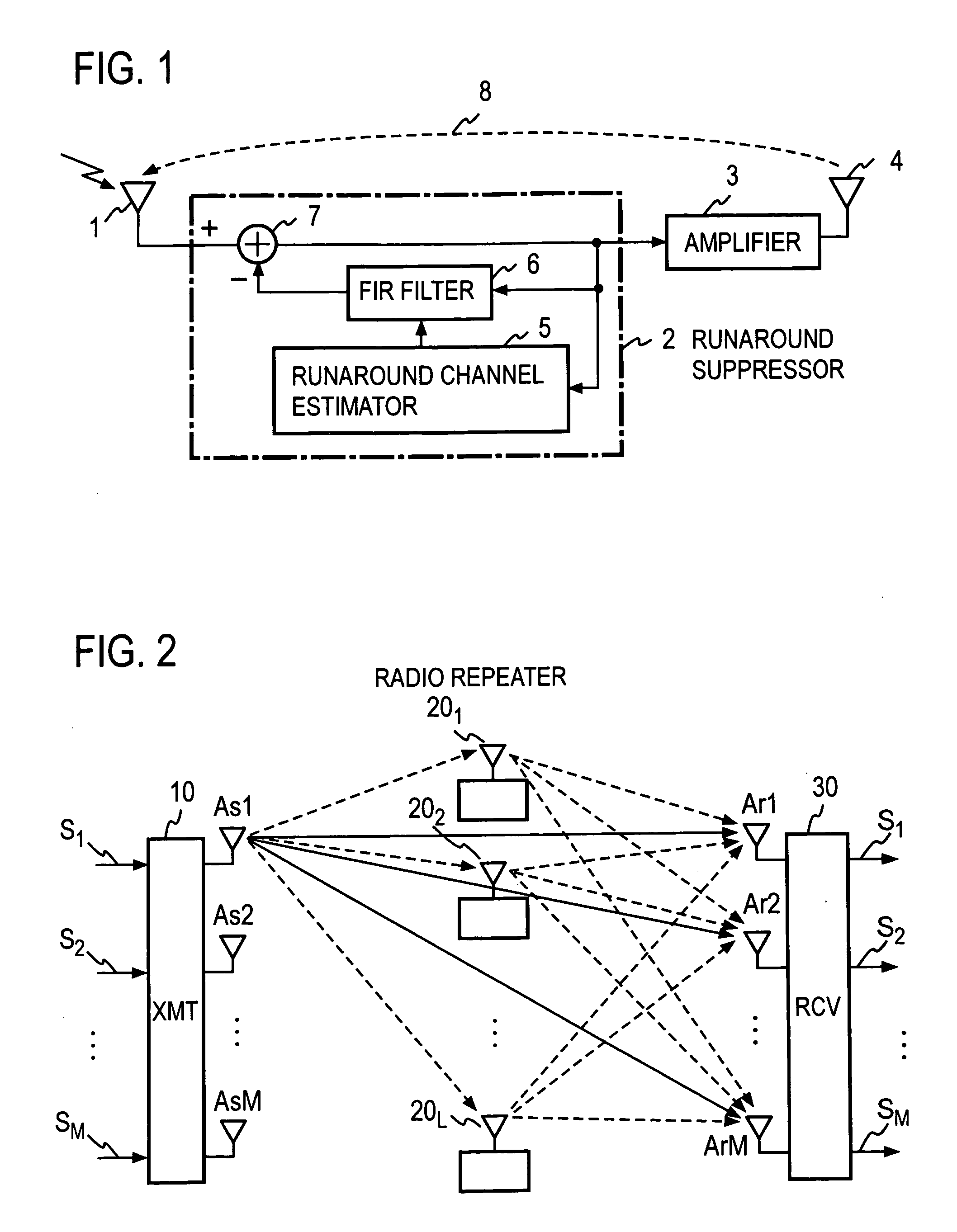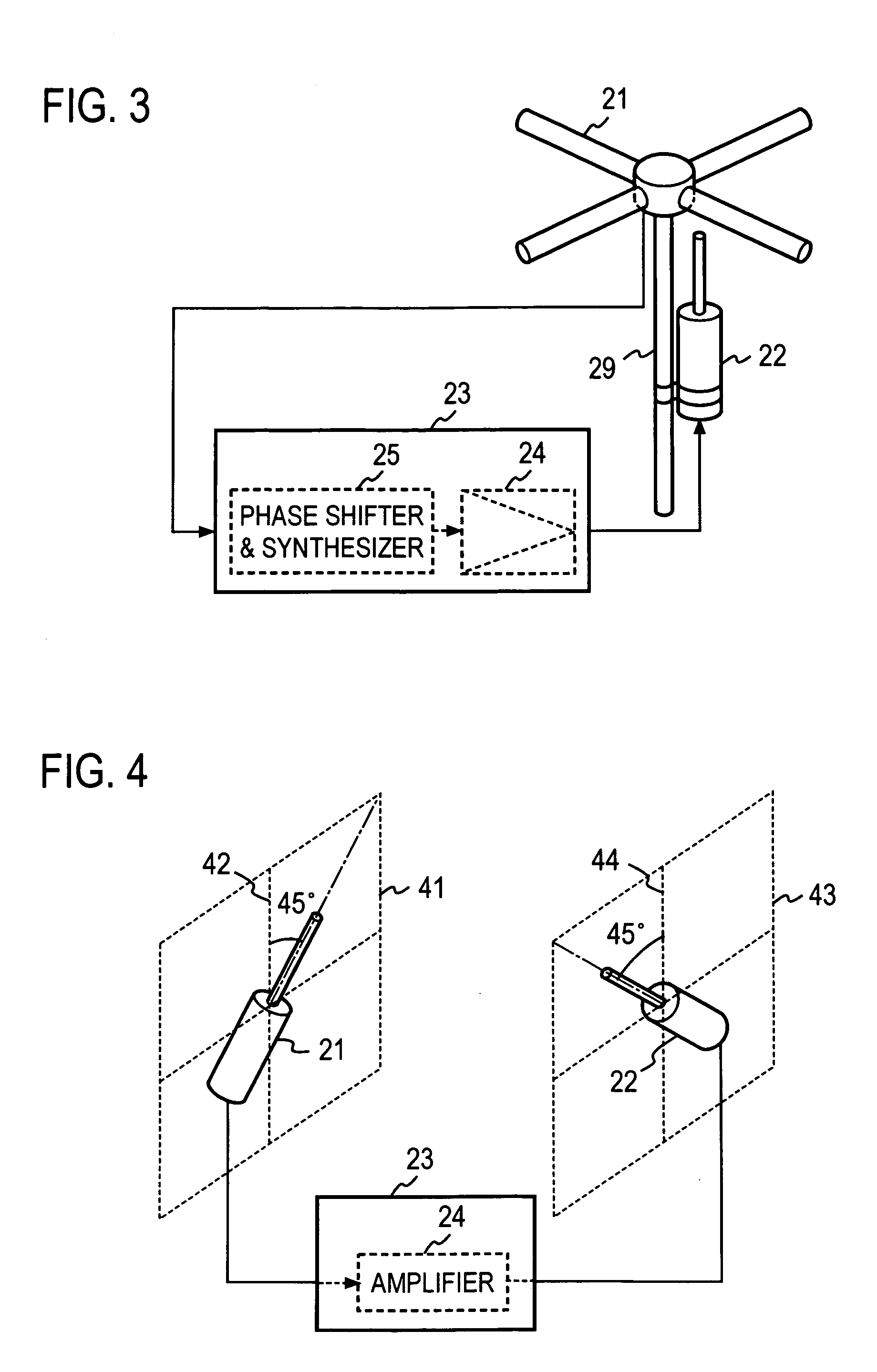Radio repeater and radio relay transmission method
a radio repeater and radio relay technology, applied in the field of radio relaying, can solve the problems of difficult to move the location of the radio repeater, inconvenient to relay in a communication system, and the amount of signals which can be transmitted is nearly halved in comparison to a continuous relaying operation, so as to reduce the coupling, increase the number of transmission paths, and increase the channel capacity
- Summary
- Abstract
- Description
- Claims
- Application Information
AI Technical Summary
Benefits of technology
Problems solved by technology
Method used
Image
Examples
embodiment 1
[0045] The likelihood of an oscillation occurring in the repeater shown in FIG. 6 arises from the following reason: for example, a radio signal received by the first-polarization reception antenna 211 is transmitted from the second-polarization transmission antenna 221 and this radio signal is received by the second-polarization reception antenna 212 through a loop interference transmission path 41. The received loop interference signal is amplified by the amplifier 242 to be transmitted from the first-polarization transmission antenna 222, and the transmitted loop interference signal is received by the first-polarization reception antenna 211 through a loop interference transmission path 42, and the received loop interference signal is amplified by the amplifier 241 to be transmitted again from the second-polarization transmission antenna 221. Thus, there arises the likelihood that the loop interference signal may circulate through the following closed path: [0046] transmission ant...
system example 1
[0056] An exemplary arrangement of a communication system to which the mode 2 can be applied is schematically shown in FIG. 8. A transmitter 10 is provided with a first-polarization and a second-polarization transmission antenna 111 and 112 having polarizations which are orthogonalized. Radio signals on a common frequency band are simultaneously transmitted from the first-polarization and the second-polarization transmission antenna 111 and 112. Information series S1 and S2 which are transmitted as radio signals from the first-polarization and the second-polarization transmission antenna 111 and 112, may be similar or dissimilar.
[0057] A radio repeater 20 is provided with a first-polarization reception antenna 21 having the same polarization characteristic of one of the first-polarization and the second-polarization antenna 111 and 112 which is the polarization characteristic of the transmission antenna 111 in the example shown, and with a second-polarization transmission antenna 2...
system example 2
[0064] A system arrangement to which the radio relay transmission method according to the present invention can be applied will be described with reference to FIG. 9 which illustrates the system arrangement in a simplified form.
[0065] A radio signal is transmitted from a first-polarization transmission antenna 11 of a transmitter 10 and is received by a first-polarization reception antenna 21 of a radio repeater 20 which has the same polarization characteristic as the first-polarization transmission antenna 11. The received radio signal is amplified and is transmitted from a second-polarization transmission antenna 22 having a polarization characteristic which is orthogonalized to the reception antenna 21 or is transmitted as a radio signal having a polarization which is orthogonalized to the polarization of the received radio signal. In a receiver 30, the radio signal is received by a second-polarization reception antenna 311 having the polarization characteristic which is identic...
PUM
 Login to View More
Login to View More Abstract
Description
Claims
Application Information
 Login to View More
Login to View More - R&D
- Intellectual Property
- Life Sciences
- Materials
- Tech Scout
- Unparalleled Data Quality
- Higher Quality Content
- 60% Fewer Hallucinations
Browse by: Latest US Patents, China's latest patents, Technical Efficacy Thesaurus, Application Domain, Technology Topic, Popular Technical Reports.
© 2025 PatSnap. All rights reserved.Legal|Privacy policy|Modern Slavery Act Transparency Statement|Sitemap|About US| Contact US: help@patsnap.com



